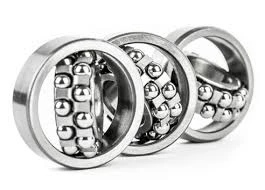
Oct . 11, 2024 12:13 Back to list
ball bearing 6214
Exploring the Significance of Ball Bearing 6214 in Mechanical Engineering
In the world of mechanical engineering, the term ball bearing often evokes the image of precision, efficiency, and reliability. Among the diverse array of ball bearings available, the 6214 model stands out due to its unique specifications and widespread applications. This article delves into the significance of ball bearing 6214, exploring its features, advantages, and prevalent uses in various industries.
The 6214 ball bearing is part of the deep groove ball bearing family, characterized by its robust design and ability to handle radial and axial loads. With an inner diameter of 70 mm, an outer diameter of 125 mm, and a width of 24 mm, the 6214 bearing is ideally suited for applications requiring high-speed performance and low friction. The construction typically includes steel or ceramic balls, which contribute to its durability and efficiency.
One of the key advantages of the 6214 ball bearing is its versatility. It can be employed in various applications ranging from household appliances to heavy machinery. In electric motors, for instance, the 6214 bearing minimizes friction, thereby enhancing energy efficiency and prolonging the lifespan of the motor. Similarly, its use in automotive applications, such as in gearboxes and wheel hubs, ensures smooth operation and improved performance.
ball bearing 6214

Additionally, the 6214 ball bearing's design facilitates easy installation and maintenance. With its standard dimensions, it can be seamlessly integrated into existing machinery without the need for extensive modifications. This ease of integration not only reduces downtime during replacements but also lowers maintenance costs, making it an economical choice for manufacturers.
Another noteworthy aspect of the 6214 ball bearing is its ability to operate effectively under various environmental conditions. Whether exposed to dust, moisture, or extreme temperatures, this bearing is designed to maintain its performance. This resilience is particularly beneficial in industries such as aerospace and agriculture, where equipment often faces challenging conditions.
With the advent of advanced manufacturing technologies, the production of ball bearings like the 6214 has become more precise. Innovations such as computer-aided design (CAD) and improvements in materials science have resulted in bearings that boast enhanced performance characteristics, including lower noise levels and greater resistance to wear.
In conclusion, ball bearing 6214 plays a crucial role in mechanical engineering by providing reliable performance in a wide range of applications. Its versatility, ease of use, and ability to withstand challenging conditions make it a preferred choice for engineers and manufacturers alike. As industries continue to evolve, the importance of high-quality components like the 6214 ball bearing will only increase, underscoring the necessity for ongoing innovation and excellence in engineering practices.
Latest news
-
The Future of Deep Groove Ball Bearings For Extreme Applications
NewsJul.31,2025
-
Self-Lubricating Bearings: The Future of Agricultural Machinery Efficiency
NewsJul.31,2025
-
Nanotechnology in Ball Bearing Machines: The Future of Friction Reduction
NewsJul.31,2025
-
How Deep Groove Ball Bearings Are Tailored for Different Uses
NewsJul.31,2025
-
Energy-Efficient Machinery Bearings: Reducing Power Consumption in Large-Scale Ball Mills
NewsJul.31,2025
-
Deep Groove vs. Angular Contact: Which Ball Bearing Wins in High-Speed Applications
NewsJul.31,2025
